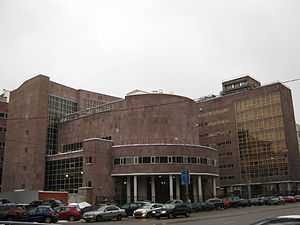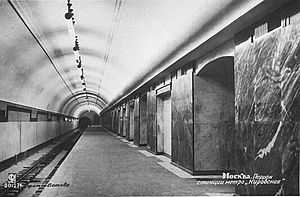Nikolai Kolli


Nikolai Dzhemsovich Kolli (1894 - 1966) was a Russian Modernist—Constructivist architect, Soviet architectural functionary, and city planner in the Soviet Union.[1]
History
Kolli was born in Moscow, and studied at the Imperial Moscow School of Painting, Sculpture and Architecture, and then at the Leninist VKhUTEMAS in Moscow.[1]
He first came to attention with a 1918 proposal for a monument celebrating the victory of the Red Army over Tzarist General Krasnov, in the form of a red wedge cleaving a block of white stone. It became an image that artist El Lissitzky subsequently appropriated in "Beat the Whites with the Red Wedge."
Nikolai Kolli is buried in the Vvedenskoye Cemetery.[2]
Modernism
Nikolai Kolli studied under Ivan Zholtovsky as one of his "Twelve Disciples." In the late 1920s became a member of both the Soviet OSA Group (Union of Contemporary Architects), and a delegate to the international CIAM (Congrès International d'Architecture Moderne) architectural group.
From 1928 through 1932 he lived part-time in Paris, assisting Le Corbusier in that architect's only built work in Moscow, the Tsentrosoyuz building (Central Cooperative Alliance offices).[3] Planning and construction[1]
Career
Kolli taught at the N. E. Bauman Moscow Higher Technical School from 1920 to 1941, and at the Moscow Institute of Architecture from 1931 to 1941.[1]
From 1935 to 1951 he headed the Moscow branch of the Soviet Union of Architects.
Works
The works of Nikolai Kolli include:
- All-Russian Agricultural and Cottage-industry Exhibition, Moscow, 1923 — collaborated in the design of a number of structures.[1]
- Dnieper Hydroelectric Station, on the Dnieper River in Zaporizhzhia, 1927-1932 — with Viktor Aleksandrovic Vesnin and others.
- Tsentrosoyuz building (Central Cooperative Alliance), Moscow, (design 1928 - 1933, built 1933) — collaboration with Le Corbusier.[1][3]
- Chistye Prudy station of the Moscow Metro, 1935.[1]
- North Pavilion for the Park Kultury station of the Moscow Metro, 1935 — with S.G. Andrievsky.[1]
- Paveletskaya station of the Moscow Metro, 1950 — with I. Kasetl.[1]
See also
| Wikimedia Commons has media related to Nikolai Kolli. |
- Constructivist architecture
- Modernist architecture in Russia
References
- ↑ 1.0 1.1 1.2 1.3 1.4 1.5 1.6 1.7 1.8 The Free Dictionary: Nikolai Dzhemsovich Kolli . accessed 11.23.2013
- ↑ Vvedenskoe.pogost.info: Nikolai Kolli, buried in Vvedenskoye Cemetery
- ↑ 3.0 3.1 The Charnel-House blog: Nikolai Kolli and Le Corbusier’s Tsentrosoiuz building in Moscow (text & vintage images) . accessed 11.23.2013.
- The Great Soviet Encyclopedia, 3rd Edition (1970-1979).
- “Arkhitektor N. Ia. Kolli.” Arkhitektura SSSR, 1964, no. 12.
|